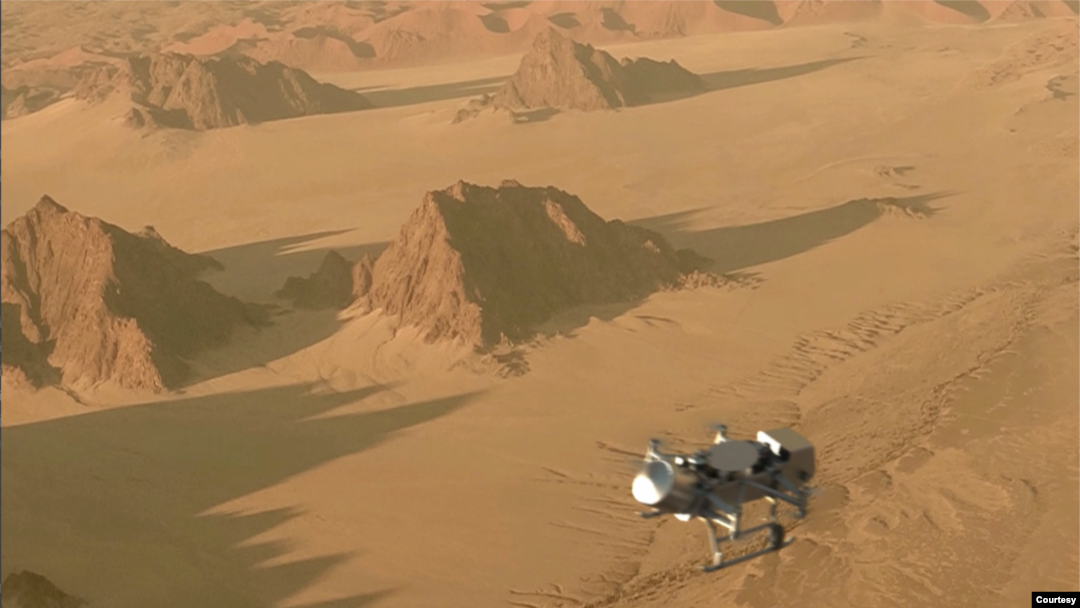Saturn’s moon Titan has all the right ingredients for life. NASA’s newly announced mission, Dragonfly, will explore the icy moon from the air and the ground to determine whether life ever arose there.
A familiar alien landscape
At first glance, Titan looks a lot like Earth. Lakes and seas are scattered across the northern hemisphere, and occasional rains dampen its sandy surface. The similarities end there – Titan is so cold that water exists as rock-hard ice, and oily methane falls from the sky and trickles into the seas. The sand is made up of organic materials built from carbon, hydrogen, nitrogen and oxygen, completely unlike what you’d find on any beach on Earth.
“One of the things I think is so exciting about Titan is how it can be alien and familiar at the same time. It’s 94 K [-290°F/-179°C] – it’s totally different material than what we’re used to interacting with on a daily basis: water-ice bedrock and liquid methane reservoirs and organic sand dunes,” said Elizabeth Turtle, Dragonfly’s principal investigator.

Titan in front of Saturn as seen by Cassini. (Image credit: NASA)
Titan’s surface is hidden from view by its hazy atmosphere, which is four times denser than Earth’s. Combined with the low gravity – just one-seventh as strong as what we’re used to – the thick atmosphere makes Titan an ideal target for an airborne explorer.
The idea of building an aircraft to fly in Titan’s thick atmosphere isn’t new, but it wasn’t until drone technology became more advanced that the Dragonfly team realized they could make their dream of flying on Titan a reality.
Leapfrogging across Titan
With its two sets of four propellers stacked on top of one another, Dragonfly looks a little bit like a drone, but it’s much bigger than something you would fly around in your backyard – around 3 meters long and more than a meter tall. The design will allow Dragonfly to take pictures from the air and land on Titan’s frozen surface for a closer view.
It will initially target a region near the moon’s equator that is covered in sand dunes, similar to what is found in deserts on Earth. From there, it will begin to explore the moon in a “leapfrog” way, scouting beyond its next target to see what lies ahead, then flying back to its planned landing site to touch down and analyze samples of the surface, snap photographs and scan for earthquakes – or titanquakes, rather.
Representative-color image of Titan's surface. (Image credit: NASA)
Traveling eight kilometers per leap, Dragonfly will make its way toward Selk crater, over 100 kilometers away. Scientists think that the heat from the collision that formed the crater would have liquefied the water ice in Titan’s crust, creating an environment with all the necessary components for life. The Dragonfly team hopes to learn whether combining organic material with liquid water and energy in the form of heat could have caused complex molecules to develop – or even life itself.
“We have this chance to explore a world that we know has all the ingredients for life, but how far did it get towards life?” said Melissa Trainer, deputy principal investigator for the mission.
Looking for life
If life has arisen on Titan, Dragonfly should be able to detect it. One thing its instruments will be on the lookout for is a class of molecules called amino acids, which are found in all life on Earth. Amino acids come in left- and right-handed varieties, just like a pair of gloves. When scientists make amino acids in a lab, they tend to form both kinds in equal amounts. Life, however, seems to prefer the left-handed kind. If amino acids are present on Titan, Dragonfly should be able to tell if there are unequal amounts of left- and right-handed varieties – a sign that life is present on the frozen surface.
Radar image of sand dunes in the Shangri-La region of Titan, where Dragonfly will land. (Image credit: NASA)
Dragonfly will launch in 2026 and arrive at Titan in 2034 after an eight-year interplanetary cruise. The science and engineering teams have plenty to do in the meantime. “We have to finish designing and building a spacecraft, we have to test a bunch of instruments and get them calibrated,” said science team member Sarah Hörst. “There’s a lot of work to do … I can’t wait to get started!”
It’s a long way off, but the team is confident that the mission will be worth the wait and is excited to share what they learn with the public. “We want everyone to be able to come along on the journey to explore Titan,” Turtle said.
Link: Johns Hopkins APL Dragonfly image gallery


